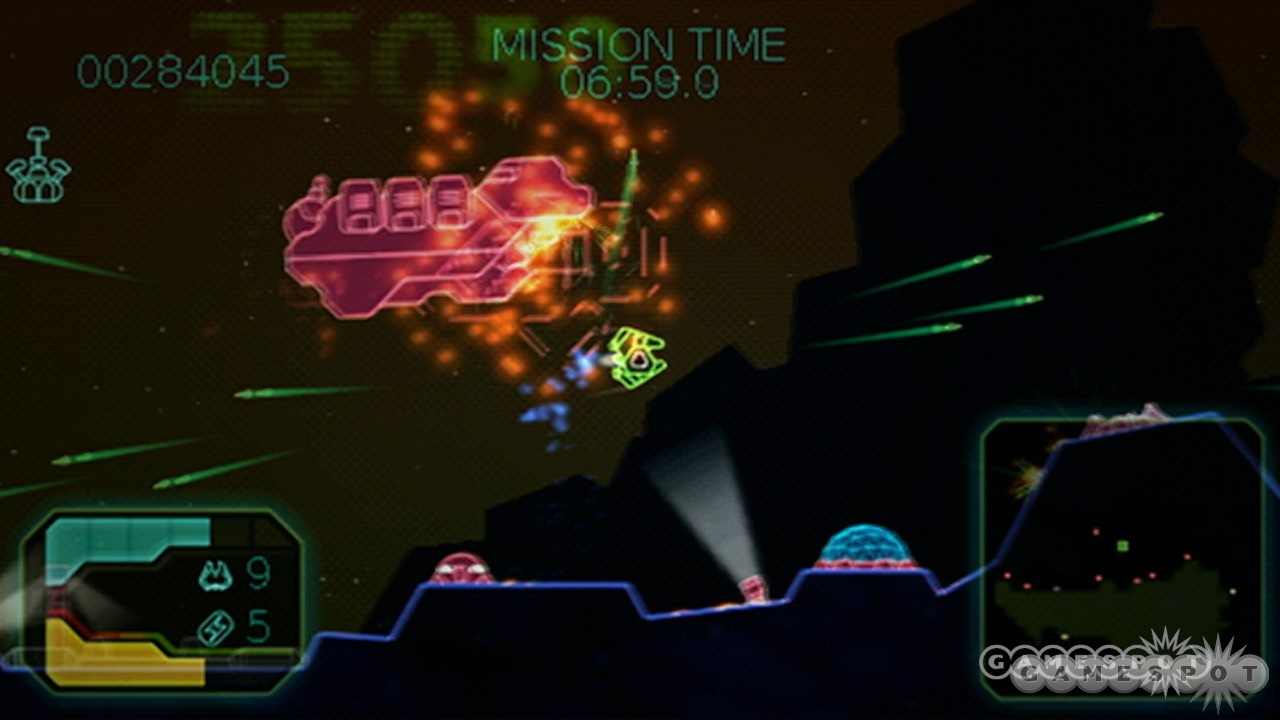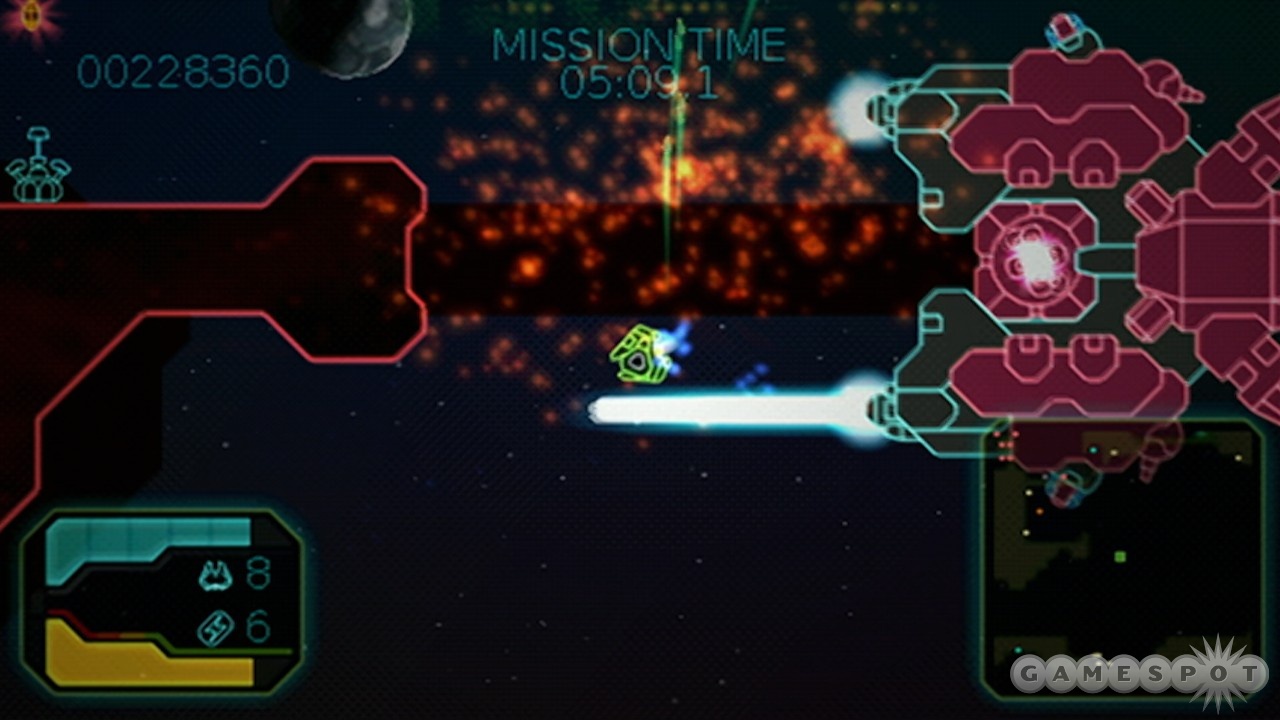Desolate planets in the deep reaches of space were one of the first frontiers explored by early arcade games. Their monochrome landscapes were created with jagged lines and only a handful of objects, yet this simplicity gave rise to some of the most addictive and entertaining games of the era. Gravity Crash Portable is a modern throwback, and though this means its scope is quite limited, it accomplishes its goals very well. This port of last year's Gravity Crash features 2D levels sketched in simple lines and a humble ship with basic abilities. Stylish design touches and clever use of gravity make this neon landscape feel strikingly modern, though the look can grow repetitive as the game progresses. Whether you are simply having fun or racing to beat the clock, the precise controls make piloting your ship a blast, even with only one analog stick at your disposal. The easy-to-use level creator is as robust as ever, but you can only share files locally, making it harder to reap the rewards of community creativity. Even so, Gravity Crash Portable retains almost all of the appeal of the original, giving PSP owners a great way to enjoy this entertaining and affordable shooter.
The fundamental activity you have to master in Gravity Crash is navigation. Your tiny ship is equipped with a shield, a thruster, a blaster, and a special weapon. How you navigate depends on your control preference. Classic controls use the analog stick for steering and assign shooting and thrusting to buttons. Dual controls rely on the analog stick for steering and thrusting, assigning directional shooting to the face buttons. While both schemes worked equally well in Gravity Crash, gameplay tweaks (the firing speed has been increased) and platform limitations (you can't see as much of the environment) make dual controls feel superior in Gravity Crash Portable. A new third control scheme, Anti Gravity, is the same as dual controls except that your ship is no longer affected by gravity. You still have inertia, and navigating is still a challenge, but the lack of gravity makes this option less engaging than the other two.
Getting the hang of the controls is easy, but don't expect to be flying around unhindered just because Gravity Crash Portable is set somewhere out in space. Every level takes place on a planet, and you have to compensate for the gravitational pull on your ship with every maneuver. You can accelerate pretty quickly from a stationary position, but if you've got some momentum going one way, turning the other way is going to take some effort and, more crucially, some time. Careening around the level at high speeds is a good way to bump into walls and deplete your shields, and it's an even riskier proposition this time around because you can see less of your surroundings than you could in Gravity Crash. You really have to get a feel for the power of your thrusters and how much inertia your ship has at any given moment. Many levels require you to go underwater where changing speeds takes more thruster power and you are constantly floating toward the surface. In later levels, strange energy fields and enemy structures spice up the gravitational mix even further. Gravity Crash's physics are exceedingly well implemented, and once you get a feel for gravity, buoyancy, and inertia, movement becomes really enjoyable. Whether you're cautiously navigating a tight, winding tunnel or confidently hurtling through areas you've traversed before, piloting your craft feels natural in a way that only responsive controls and finely tuned physics can offer.

Of course, all this flying about is not without its risks. If you fly too long without refueling, your craft becomes helpless. Shooting yellow crystals that grow on the walls will yield small shards of energy that refuel your ship. If you shoot the crystals enough times in a row, they'll disappear, but if you stop short of destroying them, they'll regrow and remain a viable fuel source (a subtle ecological message, perhaps?). These yellow crystals will also replenish your shield if you have chosen automatic shield mode (shields activate whenever needed). If you choose manual shield mode, your shields will regenerate automatically, though you have to hold a button to activate them. A shieldless ship will explode in one hit, making manual shield mode more exacting and punishing than automatic. However, speedy level times are much easier to accomplish if you don't have to stop to replenish your shields as often.
But speed isn't the key to victory in Gravity Crash; it's just a good way to boost your score. Each level has some simple objectives (collect gems, destroy enemy structures, or defeat a boss), and completing them opens up a wormhole that ends the level. Oddly, Gravity Crash Portable doesn't give you any way to see your previous scores (or anyone else's for that matter), so the only competitive benchmark is the target completion time listed for each level. You can quickly complete the objectives and zip to the exit in hopes of beating the recommended time, but there are plenty of distractions to keep you busy. Each level contains a plethora of gems, as well as a few hidden bonuses that are fun to seek out. You may also encounter friendly survivors, and if you land your craft next to them (an enjoyably tricky task), you can whisk them away to safety. And, of course, there are a wide variety of enemies trying to kill you.
Wall-mounted turrets and missile launchers are your most common threat, but mobile ships, astronauts with jetpacks, and even floating alien beings give you no end of trouble. You can blast your way through all of them (with the help of a power-up, if you're lucky), but then there are also environmental obstacles to consider. Rotating wheels and spongiform aliens obstruct passageways, while meteors, volcanoes, and lava pools present their own sorts of danger. Gravity Crash Portable features some hostile worlds, but none of them are soul-crushingly hard. The game offers a healthy, yet attainable challenge, and those interested in testing their skills beyond the campaign can take on the new Survivor mode. In this mode, you try to find gems on increasingly difficult levels within a certain time limit. Things can definitely get tense, but it's up to you to keep track of your personal best, because Gravity Crash Portable won't do it for you.

If some of the creative level layouts inspire you, you can delve into Gravity Crash Portable's map editor and make one of your own. It's a bit more user-friendly than the PlayStation 3 version, though the small screen can make the design field feel cramped. Playing your completed creation (or work-in-progress) is satisfying, but it's a shame that the only way to share levels is over an ad hoc connection. For the most part, Gravity Crash Portable is a faithful, enjoyable port of the original, though it still suffers from the inherent flaws of a relatively simple arcade game. Though the neon environments are pleasing to fly through and the bouncing techno music sets an enjoyable mood, both wear thin after a time. And while the action is finely tuned and satisfying, it also gets tiresome. Yet, thanks to the great physics and appealing presentation, the majority of your experience with this game will be fun and rewarding. For a mere $9.99, Gravity Crash Portable combines the simplistic, addictive appeal of its ancestors with modern visuals and controls to make a very entertaining blast from the past.